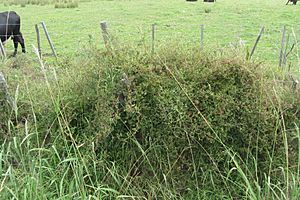Anthosachne sacandros facts for kids
Quick facts for kids Anthosachne sacandros |
|
|---|---|
 |
|
| Conservation status | |
| Scientific classification | |
| Genus: |
Anthosachne
|
| Species: |
sacandros
|
| Synonyms | |
|
Elymus sacandros Connor |
|
Anthosachne sacandros is a special type of grass. It belongs to the family of "true grasses" called Poaceae. This plant is endemic, which means it is found only in one specific place. For Anthosachne sacandros, that place is the Richmond temperate forests in the Marlborough Region of New Zealand.
This grass is a medium-sized plant that grows in tufts or clumps. It is a perennial grass, meaning it lives for many years.
Contents
Where Does This Grass Grow?
Anthosachne sacandros mostly grows near the coast. However, you can also find it further inland in some areas. It likes to grow on limestone cliffs and bluffs. It also thrives on river terraces.
This grass can be found at different heights above sea level. It grows from sea level (0 meters) all the way up to 900 meters high.
What Makes It Unique?
Anthosachne sacandros has some special features. These features help scientists tell it apart from other similar grasses. For example, it is different from a related grass called A. falcis.
Here are some of its unique traits:
- It grows upright, which is called an erect growth form.
- Its leaves are long, thin, and have ribs.
- The leaves also have a blue-green color, which is called glaucous.
- It has dense hairs where the leaf blade meets the ligule. The ligule is a small flap at the base of the leaf.
Its Life Cycle
This grass has specific times of the year when it flowers and fruits.
- It flowers from October to February. This is when the grass produces its seeds.
- It fruits from December to May. This is when the seeds are fully developed and ready.
Protecting This Special Grass
Anthosachne sacandros faces several threats. These threats can make it harder for the grass to survive.
Some of the main threats include:
- Introduced species: These are plants and animals that are not native to New Zealand. They can harm the grass. Examples include the common brushtail possum. Also, plants like Lycium ferocissimum and Pinus contorta can compete with the grass.
- Natural events: The places where this grass grows are sometimes isolated. This means they are far from other populations. These isolated groups are at risk from natural events like fires, floods, and erosion.
Protecting this unique New Zealand grass is important for its survival.


